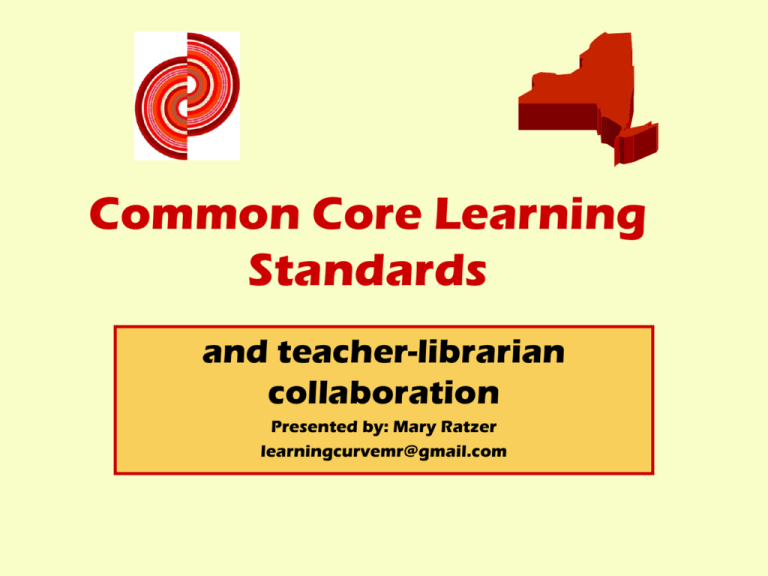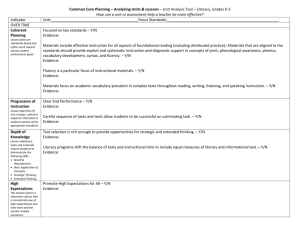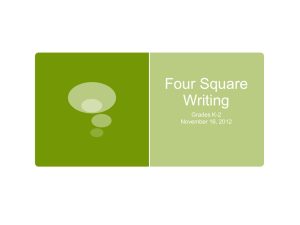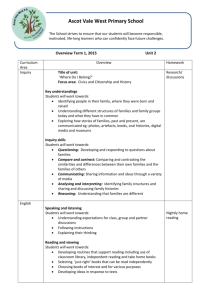Common Core Learning Standards - Teacher
advertisement

Common Core Learning Standards and teacher-librarian collaboration Presented by: Mary Ratzer learningcurvemr@gmail.com Where are we going? What is this new landscape? How are we going to get there? What are the BIG IDEAS, our starting points? Questions • How well do you understand the Common Core? • What actions will lead to mastery of the new standards? • Where is the common ground for the new standards and information fluency? • How can the Common Core be implemented through teacher/librarian partnerships? Questions • How will teaching and learning change with the Common Core Standards? • How will learner outcomes change with the Common Core? • How will teacher actions insure rigor, relevance, college and career readiness? Attitude Check? Your Questions Your expectations for today? COMMON GROUND w/ NYSED • Increase rigor • Increase the Lexile range of required reading • Make assignments relevant to the students’ real world, and • Embed research to solve problems and answer real world questions COMMON GROUND- ANCHOR STANDARDS • • • • Essential questions that Google can’t answer Solving a real-world problem Research conducted with authentic resources Learners to draw conclusions from text and summarize deep understanding, aimed at fostering long term retention • Student ownership and engagement • Student-created conclusions, authentic work COMMON GROUND Students who are COLLEGE and CAREER READY in Reading, Writing, Speaking and Listening: Demonstrate independence Build strong content knowledge Respond to varying demands of audience, task, purpose, and discipline Comprehend as well as critique Value evidence Use technology and digital media strategically and capably Understand other perspectives and cultures COMMON GROUND • Integration of knowledge and ideas: Use their experience and their knowledge…and logic to think analytically, address problems creatively, and advocate persuasively Integrate and evaluate multiple sources of information presented in different media or formats to address a question or solve a problem COMMON GROUND • Research to build and present knowledge: Conduct short as well more sustained research projects to answer a question (including a self-generated question) drawing on several sources and rating additional, related focused questions that allow for multiple avenues of exploration Develop factual, interpretive, and evaluative questions for further exploration of the topic Draw evidence from literary or informational texts to support analysis, reflection, and research Gather relevant information from multiple print and digital sources, assess the credibility and accuracy of each source, and integrate the information avoiding plagiarism COMMON GROUND • Production and distribution of Writing: Use technology, including the Internet, to produce and publish writing and to interact and collaborate with others Write arguments to support claims in an analysis of substantive topics or texts using valid reasoning and relevant and sufficient texts Explore and inquire into areas of interest to formulate an argument COMMON GROUND • Comprehension and collaboration: Integrate and evaluate information presented in diverse media and formats, including visually, quantitatively, and orally Prepare for and participate effectively in a range of conversations and collaborations with diverse partners, building on other’s ideas and expressing their own clearly and persuasively COMMON GROUND • Presentation of knowledge and ideas: Present information, findings, and supporting evidence such that listeners can follow the line of reasoning and the organization, development, and style are appropriate to task, purpose and audience Make strategic use of digital media and visual displays of data to express information and enhance understanding COMMON GROUND •Text Types and Purposes Write arguments to support claims in analysis of substantive topics or texts, using valid reasoning and relevant and sufficient evidence Write informative/explanatory texts to examine and covey complex ideas and information clearly and accurately through effective selection, organization, and analysis of content. Write narratives to develop real or imagined experiences or events using…well chosen details. COMMON GROUND-Synthesis • Combine ideas and construct arguments to support claims with clear reasons and relevant evidence. • Integrate information from several texts on the same topic in order to write or speak about the subject knowledgeably. • Determine and evaluate an author’s point of view or purpose in a text and analyze how the author acknowledges and responds to conflicting evidence or viewpoints. • Delineate and evaluate the argument and specific claims in a text, assessing whether the reasoning is sound and evidence is relevant and sufficient; recognize when irrelevant evidence is introduced. CCS- Social Studies, Science, Technology Common Ground • Analyze relevant information from multiple print and digital sources, using search terms effectively; assess the credibility and accuracy of each source; and quote or paraphrase the data and conclusions of others while avoiding plagiarism and following a standard format for citation. • Combine ideas and information to develop and demonstrate a new understanding. Common Ground • The skills and understandings students are expected to demonstrate have wide applicability outside the classroom or workplace. Students who meet the Standards readily undertake the close, attentive reading that is at the heart of understanding and enjoying complex works of literature. They habitually perform the critical reading necessary to pick carefully through the staggering amount of information available today in print and digitally. They actively seek the wide, deep and thoughtful engagement with high-quality literary and information texts that builds knowledge, enlarges experience, and broadens worldviews. They reflexively demonstrate the cogent reasoning and use of evidence that is essential to both private deliberation and responsible citizenship in a democratic republic. In short, students who meet the Standards develop the skills in reading, writing, speaking and listening that are the foundation for any creative and purposeful expression of language. • ~CCS Introduction p.3 Common Ground Role of librarian: • To be ready for college, workforce training, and life in a technological society, students need the ability to gather, comprehend, evaluate, synthesize, and report information and ideas, to conduct original research in order to answer questions or solve problems, and to analyze and create a high volume and extensive range of print and non-print texts in media forms old and new. The need to conduct research and to produce and consume media is embedded into every aspect of today’s curriculum in like fashion, research and media skills and understandings are embedded throughout the Standards rather than treated in a separate section. • ~CCS Introduction p.4 Convergence • Economic reality reflects converging expectations. Education is more valued and more necessary than ever before. • The bottom line is that today ALL high school graduates need to be prepared for some postsecondary education and/or training if they are to have options and opportunities in the job market. Convergence Get ready for some data. You can take it!! Achieve America’s Diploma Project • Economic reality reflects converging expectations. • In 1975, 12% of U.S. jobs required some postsecondary training or an associate’s degree and only 16% required a bachelor’s degree or higher. • Nearly 80% of future job openings in the next decade in the U.S. will require postsecondary education or training. • 45% will be in “middle skill” occupations, which require at least some postsecondary education and training • 33% will be in high skilled occupations for which a Bachelors degree or more is required. • By contrast, only 22% of future job openings will be “low skill” and accessible to those with a high school diploma • While the U.S. still ranks 3rd in the adults with an associates degree or higher among 30 countries, we now rank 10th among 25-34 year olds with a two-year degree Civil Rights Research on Education Roundtable Berkeley Law UNIVERSITYOF CALIFORNIA The Chief Justice Earl Warren Institute on Race, Ethnicity and Diversity Higher Standards for All: Implications of the Common Core for equity in education by Lisa Quay In sum, the Common Core initiative represents necessary first step in a renewed drive to improve the performance of the nation’s public schools. Its greatest promise lies in the opportunity it presents for achieving the longsought alignment of strong standards to the high-quality assessments, curricula, and instruction that research suggests are critical to improving student performance. Behind the scenes at S.E.D. • • • • • • • • SLMP Summit June 2009 Information Fluency Continuum NYC Regents Standards Revision Task Force International standards AASL Standards for the 21st Century Learner NY Response to the Common Core Inquiry Common ground AASL, NY SLMPE, Common Core, APPR NYC- What’s Different? • ELA Standards increase in complexity from K-12, helping • • • • • to articulate what students need to know and be able to do along this trajectory and assist with differentiation Literacy-building as a shared responsibility for all content area teachers Emphasis on teaching reading of informational text Emphasis on steadily increasing students' ability to understand more and more complex text over time Integration of research skills across standards and grades Emphasis on writing to argue, inform, and explain in the upper grades to prepare students for college-level writing NYC- What’s Different? • MATH-fewer topics; more generalizing and linking of concepts – Well-aligned with the way high-achieving countries teach math • Emphasis on both conceptual understanding and procedural fluency starting in the early grades – More time to teach and reinforce core concepts from K12 – Some concepts will now be taught later • Focus on mastery of complex concepts in higher math (e.g., algebra and geometry) via hands-on learning • Emphasis on mathematical modeling in the upper grades What’s Different? • RIGOR- Depth of Knowledge Levels- NYC • • • • • • • • • Information to Knowledge Journey- Ross Todd REACTS Taxonomy- NYC Authentic Intellectual Work- Chicago Production of writing Shared Knowledge Products Collaboration Research short and extended Reading and synthesis of quality texts Multiple formats / Technology ELA 6-12 Anchors writing: zoom’d ELA K-5 Same mantras SS, Tech, Science, & Tech Math… Imperative to collaborate for applications? Why are we talking about Inquiry today? Convergence with Inquiry • • • • • • Prior knowledge and skills Background building, vocabulary Focus Discovery, exploration Synthesis Sharing Common Ground Meaning, relevance, engagement, depth, understanding, formative knowledge in the content area are outcomes of INQUIRY. Research correlates improved student performance with the process and products of INQUIRY based learning in part due to: Common Ground Connection to prior knowledge, background knowledge, affective area, questioning, focus, personal meaning and relevance. Products that incorporate original conclusions, thinking, transformation of text vs. transfer of text, deep understanding, mastery of content knowledge, reading and writing as tools. Collaboration of teacher and school library media specialist, social interaction with teachers and peers, substantive conversation. Ongoing assessment for improvement, reflection, intervention at critical points for target skill development, instruction in information literacy. The construction of meaning, synthesis of new understandings, and sharing of products that demonstrate these things. Inquiry… Big picture ideas Construct Mastery of meaning content knowledge Linked to prior knowledge Mastery of content vocabulary Taps into innate curiosity Student focused Uses reading and writing as tools to boost literacy Collaboration Social networks Problem solving Infuses information Moves beyond rote and recall Begins with the end in mind (UBD) Meaningful questions Supports brain research Real world understanding Well-planned investigation Learning a process to answer questions (lifelong learning) Build understandings Understand perspectives Leadership from New York City AASL Standards for the 21st Century Learner Information Fluency Continuum NEW The Information Fluency Continuum provides a framework for the instructional aspects of a library program. The framework is based on three standards that form the basis for the skills and strategies that are essential for students to become independent readers and learners. Information Fluency Continuum 2010 Priority Benchmark Skills and Assessments NEW Project-Based Learning: Inspiring Middle School Students to Engage in Deep and Active Learning Inquiry Curriculum Supports lifelong learning habits Elicit and use PRIOR KNOWLEDGE Remembering AASL RESEARCH Common Core S.E.D. What’s Different? Vocabulary NYC Discover and Explore New York State Common Core Learning Standards Find the Common Ground • Ask questions, draw conclusions based on evidence Synthesize SHARE GROW IT GROW IT It is an economic imperative to insure that all children reach their full potential as a thinkers, communicators, questioners, inquirers, knowledge creators, collaborators. The Great Sunflower INQUIRY Mary’s Sunflowers Hypothesis: You can’t grown sunflowers in marigold pots. Linda’s Sunflowers








